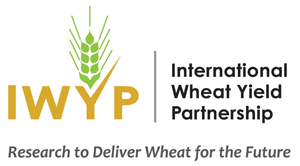Research Scope Areas
These are the current Research Scope Areas for the International Wheat Yield Partnership
Research Area A/B: Discovery or creation of genetic variation in wheat that boosts the fixation of carbon into biomass for subsequent transfer to grains
Research Area A/B involves research projects that target increasing biomass production per unit of land and time through seeking genetic variation for these traits in wheat and related germplasm not already fully exploited in breeding. This germplasm includes, but is not limited to, old landraces, synthetic wheats created using novel genetic variation in diploid and tetraploid wheats and also wheats with ancestral chromosomal introductions. The focus must be on finding major improvements in biomass production. Because of the complexity of carbon fixation and conversion into biomass, optimized smart screens will be necessary to identify component traits of efficient biomass accumulation and recognize desirable phenotypic variation. These assays should be high throughput and designed to detect variants in photosynthesis, carbon assimilation into sugars, cell walls and biomass growth rates under varying environmental conditions. Simple genetic variants within wheat may fail to unlock the significantly higher rates of carbon fixation into biomass required for a step-change in the genetic yield potential. Therefore, biotech traits based on introducing genes that encode divergent proteins or having distinct expression patterns will be considered. For example, genes that optimize canopy and spike photosynthesis, increase RuBP regeneration or thermostability of associated enzymes; genes that influence source:sink relationships, partitioning, plant architecture, or grain size and number; and introducing novel RuBisCo’s or chloroplast CO2 pumps will be considered within the IWYP research scope.
Research Area C: Maximizing grain yields from enhanced carbon capture and biomass through optimizing plant phenology
This Research Area is focused on the optimization of wheat plant phenology with advantageous genetic variation to find the best ideotypes to maximize grain yields from enhanced carbon capture and biomass. This will require smart breeding involving the use of carefully selected parents to test for and select the best outcomes for yield. It may also require additional genetic variants such as those discovered in Research Area A/B. Further, the genetic basis of the optimum ideotypes should be defined by combinations of molecular markers for future breeding advances. The environments in terms of temperature, other stresses, photoperiods and length of growing season vary around the world and influence carbon capture and the timing and efficiency of carbon transfer to the grain during development. This means that genetic variation for carbon capture will also need to be optimized with the appropriate phenology for the major environments in which the crops are to be grown. CIMMYT will be a key partner component for validation, breeding, and testing in diverse relevant environments. Other organizations with the relevant competences are also welcome as members of consortia.
Research Area D: Building elite lines for dispersal to other breeding programs
The stacking of outstanding traits into elite germplasm and taking care of the relevant trade-offs to create wheat lines with much higher yield potential is a natural extension of Research Area C. The discoveries in Research Areas A/B and C will culminate here. However, as it is likely that useful and validated genetic variation for carbon capture, increased biomass, and optimized ideotypes exists in ongoing research programs, desirable research activity directly in this area is invited.
Research Area E: Taking advantage of discoveries coming from other species
There is universal recognition that wheat improvement is held back by the lack of certain technologies and genetic knowledge behind traits relative to some other more intensely developed crops such as corn, rice and barley. It is recognized that discovery of specific genes and pathways for photosynthesis, flowering time, biomass accumulation, carbon fixation, carbohydrate partitioning and mobilization, grain size and number; systems for genomic selection; etc. in other crops can all be used to find genes with similar function in wheat. Therefore, where there is sound knowledge of important genes and systems in other species that have a high probability of translating to wheat to increase genetic yield potential proposals to exploit these species for the purposes of wheat will be considered within the IWYP research scope.

